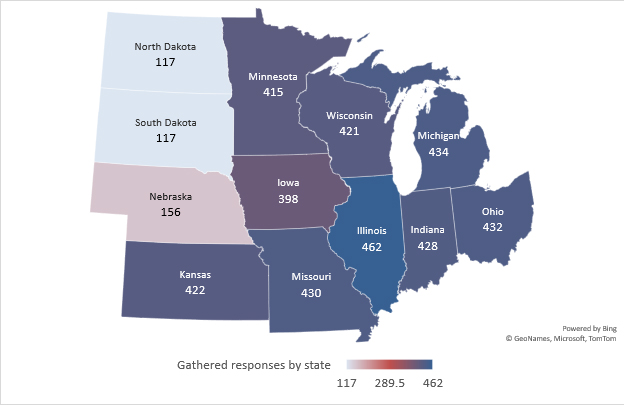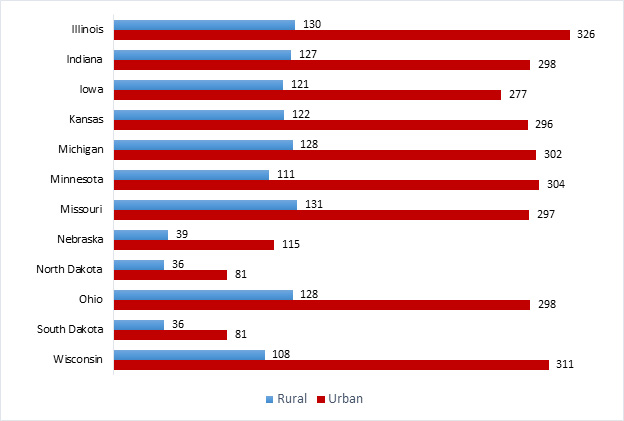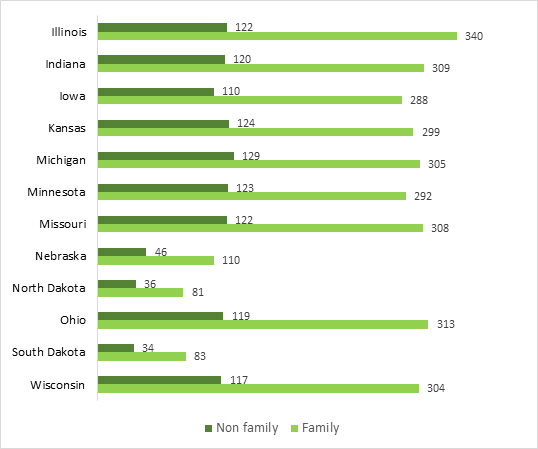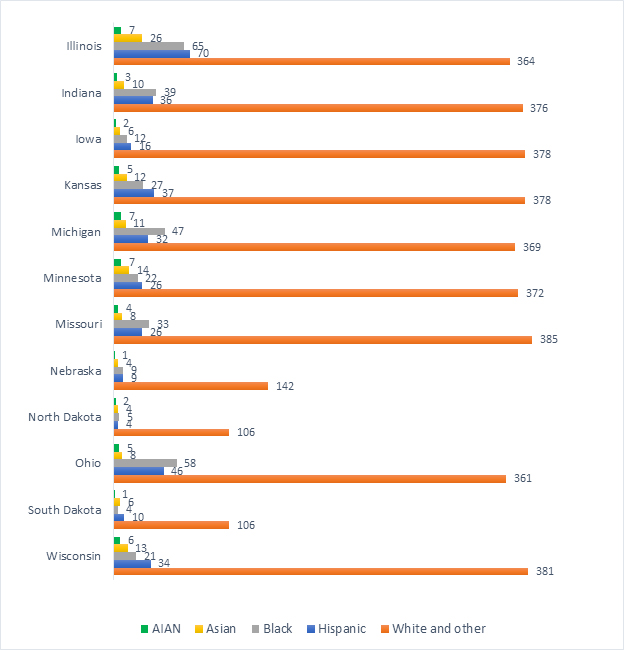By Zuzana Bednarik, Ph.D.
Introduction to the NCR-Stat
A North Central Region dataset (NCR-Stat) has been developed as a venue and incentive for interdisciplinary collaboration across land-grant universities in the North Central Region (NCR). [1] The North Central Regional Center for Rural Development (NCRCRD) maintains the baseline data and integrates them across time and space.
The NCRCRD collects household data emphasizing demography, economics, health, housing, community development, environment, and social behavior. The dataset includes primary economic and social data collected at the state level focused on households, businesses, and community wellbeing. In addition, the dataset contributes to the effort to understand the conditions and issues facing rural communities within the NCR in the three topical areas of NCRCRD: creating resilient communities and economies, developing leadership and civic engagement, and promoting community health and wellness.
Making this dataset available decreases the barriers for institutions to study regional changes and trends and conduct comparative research. Moreover, regional data collection encourages collaboration between research and Extension and high- and low-resource institutions across the region.
Moving forward, the NCRCRD will facilitate collaboration aimed at additional survey development, data collection method enhancement, and robust data analysis leading to publications and educational curricula. In addition, collaborating institutions may choose to oversample their states and provide funds to include focused topics in the survey.
Introduction to the NCR-Stat: Baseline Survey
The NCR-Stat: Baseline Survey is the first of NCRCRD’s regional household surveys and includes questions related to topics crucial for household and community development and wellbeing. All data gathered via the NCR-Stat Baseline Survey will be available for those who would like to use the data as a baseline for further research and extend the portfolio of already existing databases.
The NCR-Stat: Baseline Survey is a 20-minute survey designed to provide a baseline from a social and economic perspective. The survey focuses solely on households in the NCR states and asks questions about household demographics, income, workforce participation, entrepreneurship, caregiving, human capital, housing, broadband access, placemaking, community leadership, and civic engagement, health and wellness, food security, and environment.
The primary purpose of this initial survey is to get a better picture of the NCR and learn more about respective topics. The Baseline Survey is also a starting point for following surveys on specific thematic areas.
To collect the necessary data, we designed an online survey using Qualtrics. The goal was to maximize participation in the survey throughout the states, across rural and urban areas, household types, and race and ethnicity.
Qualtrics® distributed the survey and gathered data based on pre-defined sampling quotas and screening questions. Based on the population characteristics of each NCR state, Qualtrics® applied two different data gathering methods. An online survey was distributed to households in Illinois, Indiana, Iowa, Kansas, Michigan, Minnesota, Missouri, Ohio, and Wisconsin. A mixed-method approach (online panel and Computer Assisted Telephone Interviewing – CATI) was used in Nebraska, North Dakota, and South Dakota. Figure 1 shows the total number of responses by state.
Figure 1. NCR-Stat: Baseline Survey, respondents by state (N=4232)

We implemented multiple quotas to improve the representation of particular household types within all households and ensure that these households are not over-represented. We specified quotas reflecting the following characteristics: a share of rural and urban households, a share of family and nonfamily households, and a share of households by race and Hispanic origin of the householder.
Share of urban and rural households
Based on statistics provided by the U.S. Census Bureau, we defined the rural/urban [2] quota so that the sample consists of 70% of urban households and 30% of rural households (Figure 2).
Figure 2. NCR-Stat: Baseline Survey, number of respondents by state and rural/urban location (N=4,203)

Share of family and nonfamily households
We used household statistics [3] and identified the household type quota intending to have a sample comprising 64% of family households and 36% of nonfamily households. The final quota resulting from the survey responses is 71% family households and 29% nonfamily households (Figure 3).
Figure 3. NCR-Stat: Baseline Survey, number of respondents by state and household type (N=4,232)

Households by race and Hispanic origin of the householder
Using U.S. Census Bureau data [4], we defined quotas for the categories of race and ethnicity of a householder as follows: 8% Black, 8% Hispanic, 2% American Indians and Alaska Native, 3% Asian, 87% White (includes other races/ethnicities not specified above) (Figure 4).
Figure 4. NCR-Stat: Baseline Survey, number of respondents by state, race, and Hispanic origin (N=4,232)

Baseline Survey types of households
Nonfamily household consists of a householder living alone or with nonrelatives only, for example, with roommates or an unmarried partner. In all NCR states, except North Dakota, most non-family households were headed by females (Figure 5). Twenty-two percent of female heads of non-family households are divorced (compared to 10% of male heads of non-family households) and live alone. Moreover, 11% of female heads of non-family households are widowed, 7% more than male heads of non-family households.
Figure 5. Heads of non-family households by gender and state (N=1377)
| Residential State | Female head of household | Male head of household |
| Illinois | 58% | 42% |
| Indiana | 70% | 30% |
| Iowa | 75% | 25% |
| Kansas | 67% | 33% |
| Michigan | 64% | 36% |
| Minnesota | 64% | 36% |
| Missouri | 63% | 37% |
| Nebraska | 60% | 40% |
| North Dakota | 50% | 50% |
| Ohio | 61% | 39% |
| South Dakota | 70% | 30% |
| Wisconsin | 68% | 32% |
| NCR | 65% | 35% |
Family household consists of a householder and one or more other people living in the same household who are related to the householder by birth, marriage, or adoption. Most family households in all NCR states reported a couple as the head of their household (Figure 6). Disparities between the share of male and female heads of family households in the NCR states result from the different marital status of the survey participants and their willingness to complete the survey.
Figure 6. Heads of family households by gender and state (N=3296)
| Residential State | Couple as heads of household | Female head of household | Male head of household |
| Illinois | 47% | 29% | 23% |
| Indiana | 56% | 23% | 21% |
| Iowa | 52% | 27% | 19% |
| Kansas | 54% | 25% | 20% |
| Michigan | 55% | 26% | 17% |
| Minnesota | 52% | 26% | 22% |
| Missouri | 55% | 27% | 17% |
| Nebraska | 43% | 19% | 38% |
| North Dakota | 37% | 17% | 44% |
| Ohio | 48% | 32% | 19% |
| South Dakota | 46% | 14% | 40% |
| Wisconsin | 59% | 23% | 16% |
| NCR | 52% | 25% | 22% |
References
[1] Bednarikova, Z.; Marshall, M. I.; Wiatt, R. D.; Wilcox, Jr, M. D. (2022). North Central Region Household Data (NCR-Stat): Baseline Survey. Purdue University Research Repository. doi:10.4231/2DEM-Z333
[1] U.S. Census Bureau: https://www.census.gov/library/visualizations/interactive/race-and-ethnicity-in-the-united-state-2010-and-2020-census.html
[2] StatsIndiana: http://www.stats.indiana.edu/dms4/new_dpage.asp?profile_id=335&output_mode=1
[3] NCRCRD uses the U.S. Census Bureau and Office of Management and Budget’s delineations of rural and urban areas. For more information, see https://ncrcrd.ag.purdue.edu/2022/01/20/rural-urban-classification-used-by-ncrcrd/
Author
Zuzana Bednarik, Ph.D., Research and Extension Specialist, North Central Regional Center for Rural Development
Download article
Cite this work
Researchers should cite this work as follows:
Bednarik, Z. (2022, August 26). NCR-STAT and NCR-Stat: Baseline Survey Introduction. North Central Regional Center for Rural Development. https://ncrcrd.ag.purdue.edu/2022/08/26/ncr-stat-and-ncr-stat-baseline-survey-introductio/
